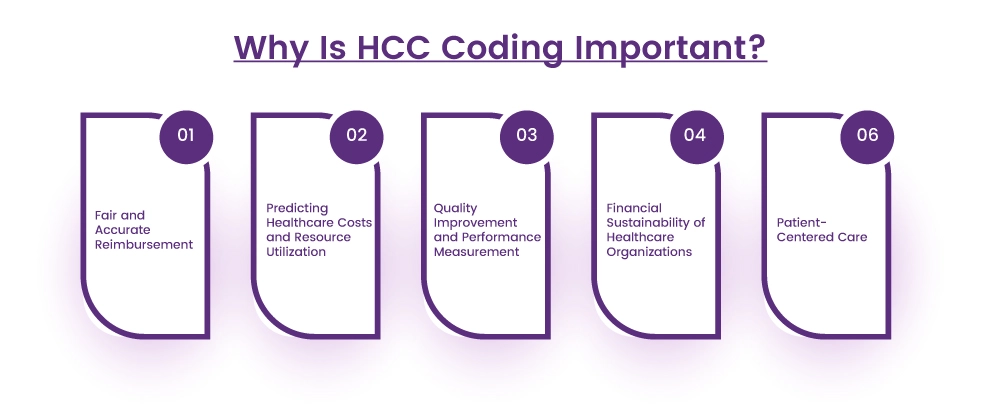The shift from fee-for-service to paying for quality outcomes is revolutionizing how you approach patient care and reimbursement. But what does this mean for you? It means that understanding HCC coding (Hierarchical Condition Category coding) isn't just a nice-to-have, it's a must-have skill.
Why? Because accurate HCC coding is the cornerstone of risk adjustment, the process ensures you're fairly reimbursed for the complexity of your patient's conditions. In the world of value-based care, where your payment is tied to patient outcomes, accurate HCC coding can be the difference between thriving and merely surviving.
In this blog post, we'll break down the essentials of HCC coding, explore its critical role in value-based care, and provide you with actionable strategies to improve your coding accuracy and, ultimately, your bottom line.
What Is HCC Coding?
HCC, a medical abbreviation for Hierarchical Condition Category Coding, is a risk-adjustment model used primarily by Medicare Advantage plans and some Medicaid programs. Introduced by the Centers for Medicare & Medicaid Services (CMS) in 2004, HCC coding plays a crucial role in determining how much these plans are paid to care for their members.
In essence, HCC coding is a way to categorize patients based on their health conditions. Each HCC represents a specific diagnosis, and each diagnosis is assigned a risk score based on its potential impact on healthcare costs. The higher the risk score, the more complex and costly the patient's care is likely to be.
What Does HCC Mean In a Diagnosis?
In the context of a diagnosis, HCC doesn't refer to a specific disease or condition itself. Instead, it's a category assigned to a diagnosis based on its severity and expected healthcare costs. Think of it like this: you receive a diagnosis of diabetes. That's the specific condition you have. But in the HCC coding system, your diabetes diagnosis might fall into a specific HCC category, such as HCC18, which represents uncomplicated diabetes. A patient with diabetes and end-stage renal disease, a more complex condition, might be assigned HCC19.
What Is Risk Adjustment Factor Score & Its Link With HCC?
The Risk Adjustment Factor (RAF) score is a numerical value that summarizes a patient's overall health status and predicted healthcare costs. It's calculated using a combination of factors, including:
-
Demographic information: Age and gender
-
HCC codes: The specific HCC categories assigned to a patient's diagnosis
Each HCC category is associated with a specific risk weight, which reflects the relative costliness of that condition. The RAF score is calculated by summing the risk weights of all the HCCs a patient has and adjusting for demographic factors.
Here's where the link between HCC and RAF becomes clear:
-
Accurate HCC coding is essential for calculating a patient's RAF score accurately. The more complete and accurate the HCC coding, the more accurately the RAF score will reflect the patient's true health status and predicted healthcare costs.
-
The RAF score directly impacts reimbursement. In risk-adjusted payment models, the RAF score is used to determine the amount of payment a provider or health plan receives for caring for a patient. A higher RAF score indicates a more complex and costly patient, resulting in higher reimbursement.
Risk Adjustment Factor (RAF) Score Calculation Example
Scenario: A 65-year-old female patient with a history of:
-
Congestive Heart Failure (CHF)
-
Chronic Kidney Disease (CKD) Stage 3
-
Asthma with exacerbations requiring oral steroids
-
Type 2 Diabetes with complications
|
Factor |
Description |
Value for Patient |
Risk Weight |
|
Demographics |
|||
|
Age |
Patients are typically grouped into age bands (e.g., 0-18, 19-34, 35-49, etc.). Each age band has a corresponding risk weight. |
65 years old |
1.057 |
|
Gender |
Male or female. Each gender has a specific risk weight. |
Female |
1.05 |
|
HCCs (Hierarchical Condition Categories) Each HCC represents a group of diagnoses with similar levels of complexity and expected costs. Each HCC has a specific risk weight. The risk weights of all a patient's HCCs are added together. |
|||
|
HCC 85 (Congestive Heart Failure) |
Yes |
0.322 |
|
|
HCC 134 (Chronic Kidney Disease Stage 3) |
Yes |
0.246 |
|
|
HCC 112 (Asthma with Exacerbations) |
Yes |
0.169 |
|
|
HCC 18 (Diabetes with Chronic Complications) |
Yes |
0.417 |
|
|
Total HCC Risk Weight |
Sum of the risk weights of all the patient's HCCs. |
1.154 |
|
|
Interaction Factors |
These account for the combined effect of certain HCCs that may increase the patient's overall risk beyond the sum of their individual risk weights. |
||
|
Diabetes with Chronic Complications + Congestive Heart Failure + Chronic Kidney Disease |
This interaction factor accounts for the increased risk when all three conditions are present. |
Yes |
0.267 |
|
Total Risk Score |
Calculated by adding the demographic risk weights, total HCC risk weight, and interaction factors. |
2.478 |
|
As the patient had diabetes, heart failure, and chronic kidney disease. This combination triggered an interaction factor, adding an additional 0.267 to her RAF score. This reflects the fact that managing these three interacting conditions is likely more complex and costly than managing each one individually.
Key Points to Remember:
-
Not all combinations of HCCs have interaction factors.
-
Interaction factors can be positive (increasing the RAF score) or negative (decreasing it), depending on the specific combination of conditions.
-
The interaction factors used in risk adjustment models are based on extensive data analysis and clinical expertise.
Why Is HCC Coding Important?
HCC coding is far more than just a bureaucratic requirement – it's a linchpin in the modern healthcare system. Its importance stems from several key factors:

Fair and Accurate Reimbursement:
-
Value-based care: In the era of value-based care, providers are rewarded for delivering quality outcomes rather than the volume of services. HCC coding helps ensure that providers receive appropriate reimbursement based on the complexity of their patient population.
-
Risk adjustment: By accurately capturing the health status of patients, HCC coding helps to level the playing field, ensuring providers are fairly compensated for caring for patients with chronic conditions and complex needs.
Predicting Healthcare Costs and Resource Utilization:
-
Proactive planning: HCC codes help predict a patient's future healthcare needs. This allows healthcare organizations to allocate resources effectively, plan for care, and identify patients who may benefit from preventive interventions.
Quality Improvement and Performance Measurement:
-
Identifying gaps in care: HCC coding can reveal areas where patients are not receiving optimal care, helping providers identify and address potential quality improvement opportunities.
-
Benchmarking performance: By comparing risk-adjusted outcomes, healthcare organizations can identify high-performing providers and learn from their best practices.
Financial Sustainability of Healthcare Organizations:
-
Accurate budgeting and forecasting: HCC coding helps healthcare organizations accurately forecast healthcare costs and allocate resources effectively.
-
Mitigating financial risk: By accurately capturing the risk profile of their patient population, healthcare organizations can better manage financial risk and ensure financial stability.
Patient-Centered Care:
-
Tailored treatment plans: HCC coding helps providers develop personalized care plans that address the specific needs of each patient.
-
Improved patient outcomes: By focusing on quality outcomes and preventive care, HCC coding can contribute to better patient outcomes and improved quality of life.
Words by Author
In short, HCC coding is not just about numbers; it's about people. It's about ensuring that patients receive the right care at the right time, that providers are fairly compensated for their work, and that healthcare organizations can continue to deliver high-quality care to their communities.
By understanding and mastering HCC coding, healthcare providers can steer the complexities of the modern healthcare landscape and position themselves for success in the era of value-based care.
ABOUT AUTHOR

HMS
As a blog writer with years of experience in the healthcare industry, I have got what it takes to write well-researched content that adds value for the audience. I am a curious individual by nature, driven by passion and I translate that into my writings. I aspire to be among the leading content writers in the world.
